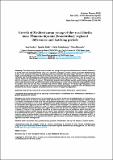Por favor, use este identificador para citar o enlazar a este item:
http://hdl.handle.net/10261/243084COMPARTIR / EXPORTAR:
 SHARE
BASE SHARE
BASE
|
|
| Visualizar otros formatos: MARC | Dublin Core | RDF | ORE | MODS | METS | DIDL | DATACITE | |

| Título: | Growth of Mediterranean young-of-the-year bluefin tuna Thunnus thynnus (Scombridae): regional differences and hatching periods |
Autor: | Gordoa, Ana CSIC ORCID ; Fraile, Igaratza; Arrizabalaga, H.; Raventós, Núria CSIC ORCID | Palabras clave: | Daily growth Young-of-the-year Juveniles Mediterranean Atlantic bluefin tuna Thunnus thynnus Crecimiento diario Jóvenes del año Mediterráneo Atún rojo del Atlántico |
Fecha de publicación: | 2021 | Editor: | Consejo Superior de Investigaciones Científicas (España) | Citación: | Scientia Marina 85(2) : 61-69 (2021) | Resumen: | [EN]This study analyses growth rates of bluefin tuna young-of-the-year in the Mediterranean. Potential differences in growth rates were examined between years (2013 and 2016) and regions (eastern, central and western Mediterranean). A total of 134 specimens were aged by analysing otolith microstructure. Fish sizes ranged between 14.7 and 57 cm fork length, and estimated ages varied between 45 and 192 days. The annual growth models explained more than 90% of growth variability. The observed differences in the growth rates between 2013 (3.2 mm d–1) and 2016 (2.7 mm d–1) were not significant, whereas the daily growth rate was significantly faster in the eastern region (4.01 mm d–1) than in the western (2.52 mm d–1) and central (2.75 mm d–1) regions. Larval hatching windows were consistent with the known spawning periods but lasted longer than previously reported in the central and eastern regions. In the central region the hatching period showed two peaks in mid-June and mid-July, consistent with previous studies pointing to two distinct spawning pulses. These pulses might be due to the existence of different bluefin tuna contingents spawning at different times, the Mediterranean residents and the Atlantic migrants, but further research is needed to support this hypothesis. [ES]Este estudio analiza las tasas de crecimiento de los alevines de atún rojo en el Mediterráneo. Se examinaron las posibles diferencias en las tasas de crecimiento entre diferentes años: 2013 y 2016 y diferentes regiones: oriental, central y occidental. Se determinó la edad de un total 134 ejemplares analizando la microestructura de los otolitos. Las tallas de los peces oscilaron entre 14,7 y 57 cm de longitud furcal, las edades estimadas variaron entre 45 y 192 días. Los modelos de crecimiento anual explicaron más del 90% de la variabilidad del crecimiento. Las diferencias observadas en las tasas de crecimiento entre 2013 (3,2 mm d–1) y 2016 (2,7 mm d–1) no fueron significativas, mientras que la tasa de crecimiento diaria fue significativamente más rápida en la región oriental (4,01 mm d–1) que en las regiones occidental (2,52 mm d–1) y central (2,75 mm d–1). Los periodos de eclosión de las larvas coincidieron con los periodos de desove conocidos, pero en las regiones central y oriental duraron más de lo que se había informado anteriormente. En la región central el periodo de eclosión mostró dos picos, a mediados de junio y a mediados de julio, lo que coincide con estudios anteriores que señalan dos pulsos de desove distintos. Estos pulsos podrían deberse a la existencia de diferentes contingentes de BFT, los residentes del Mediterráneo y los migrantes del Atlántico, que desovarían en momentos diferentes, pero para apoyar esta hipótesis es necesario investigar más. | Descripción: | Este artículo contiene 9 páginas, 2 tablas, 4 figuras. | Versión del editor: | https://doi.org/10.3989/scimar.05108.006 | URI: | http://hdl.handle.net/10261/243084 | ISSN: | 0214-8358 | E-ISSN: | 1886-8134 |
| Aparece en las colecciones: | (CEAB) Artículos |
Ficheros en este ítem:
| Fichero | Descripción | Tamaño | Formato | |
|---|---|---|---|---|
| Gordoa 2021.pdf | 1,22 MB | Adobe PDF |  Visualizar/Abrir |
CORE Recommender
Page view(s)
168
checked on 16-abr-2024
Download(s)
178
checked on 16-abr-2024
Google ScholarTM
Check
NOTA: Los ítems de Digital.CSIC están protegidos por copyright, con todos los derechos reservados, a menos que se indique lo contrario.


